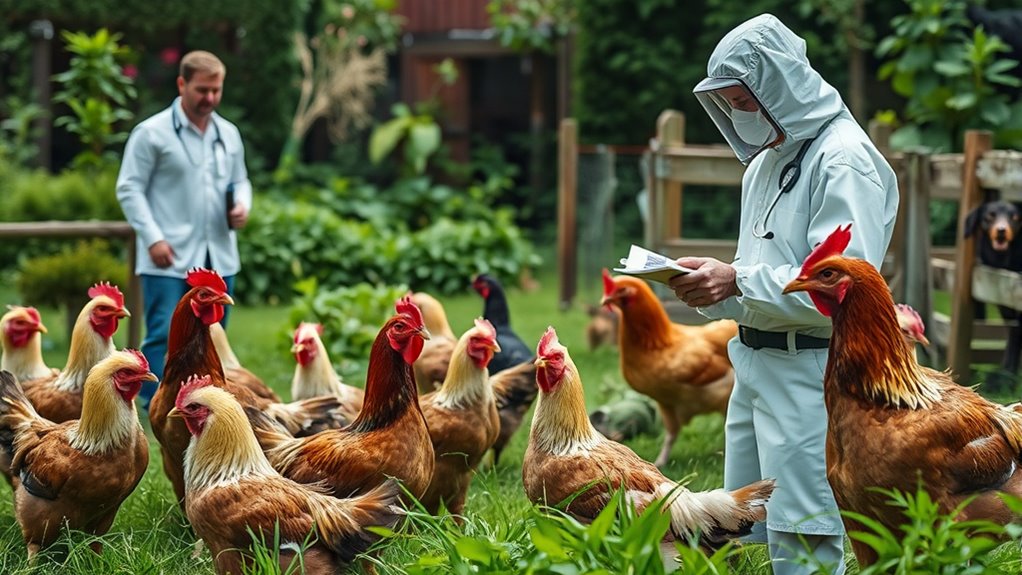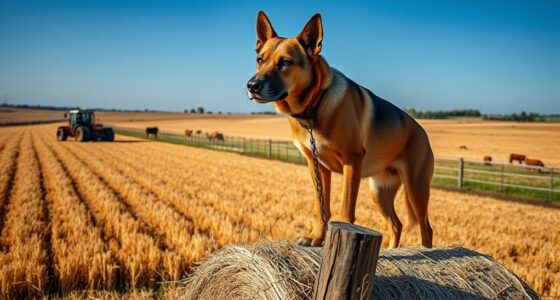To manage wildlife diseases threatening your farm animals, it’s crucial to monitor wildlife behavior and keep an eye out for signs of intrusion like damaged fencing or unusual animal health issues. Implement strong biosecurity measures, such as control access, disinfect equipment, and secure feed storage. Use physical barriers to prevent wildlife from entering livestock areas. Vaccinate your herd and stay in touch with wildlife agencies for updates. If you want to learn more strategies, keep exploring effective management approaches.
Key Takeaways
- Implement strict biosecurity measures, including fencing, disinfectant protocols, and controlled access to prevent wildlife contact.
- Regularly monitor livestock health and observe for early signs of disease and wildlife intrusion.
- Vaccinate herd against prevalent diseases and establish quarantine zones for new or sick animals.
- Manage farm environment by securing feed and waste, and maintaining barriers to deter wildlife entry.
- Conduct ongoing surveillance, coordinate with authorities, and develop rapid response plans for disease outbreaks.
Understanding Wildlife Diseases and Their Impact on Livestock
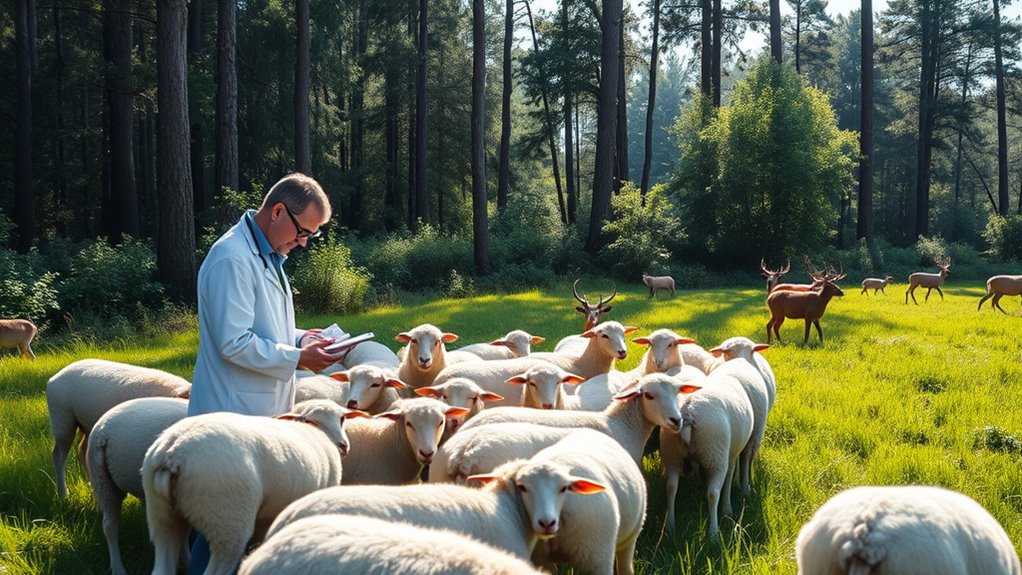
Have you ever wondered how diseases in wildlife can affect your livestock? Wildlife can carry various pathogens that, even without showing symptoms, pose serious risks to your animals. These diseases can spread through direct contact or contaminated environments, like shared water sources or grazing areas. Infected wildlife can introduce new diseases into your farm, sometimes leading to outbreaks that threaten your herd’s health and productivity. Understanding these risks helps you recognize how wildlife acts as a reservoir for pathogens. By monitoring wildlife populations and their behaviors, you can better anticipate potential threats. This awareness is essential for implementing effective biosecurity measures that protect your livestock from unseen disease transmission, ensuring your farm stays healthy and productive. Recognizing the importance of wildlife disease dynamics can further enhance your preventative strategies.
Common Wildlife Pathogens Affecting Farm Animals
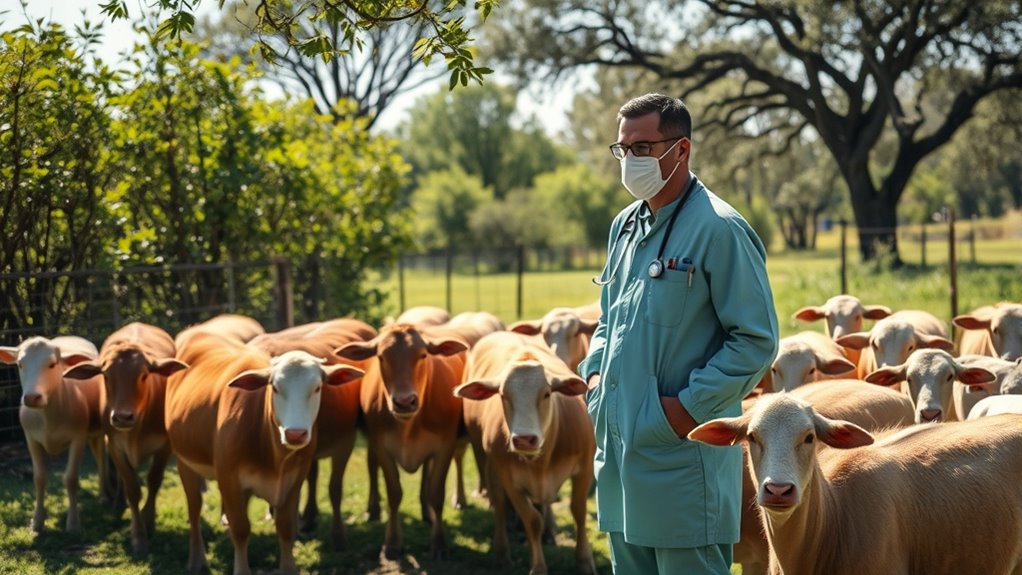
Wildlife can transmit bacterial infections, viral diseases, and parasitic infestations that threaten your farm animals. These pathogens spread through direct contact, contaminated environments, or vectors like insects. Understanding these risks helps you develop better strategies to protect your livestock effectively. Additionally, implementing halal livestock management practices can help reduce the transmission of these diseases and promote healthier farm environments.
Bacterial Infections Transmission
Bacterial infections can easily spread from wildlife to farm animals, especially when they share grazing areas or water sources. Pathogens like Salmonella, E. coli, and Campylobacter are common culprits. Wildlife such as birds, rodents, and wild boars can carry these bacteria without showing symptoms, making them silent carriers. When farm animals come into contact with contaminated soil, water, or feed, they risk infection. These bacteria often survive in the environment, increasing exposure chances. Poor sanitation, overcrowding, and shared resources heighten the risk. To prevent transmission, you should control wildlife access to feed and water sources, maintain clean facilities, and regularly monitor animals for signs of illness. Effective management reduces the likelihood of bacterial outbreaks and safeguards your livestock health. Additionally, understanding the regional flavors and traditions associated with local culinary arts can inspire innovative farm-to-table practices that emphasize freshness and safety.
Viral Disease Risks
Viral diseases pose significant risks to farm animals when wildlife act as carriers of pathogens such as Foot-and-Mouth Disease virus, rabies, and avian influenza. These viruses can spread quickly, causing outbreaks that threaten livestock health and productivity. You need to be aware of how wildlife can transmit these diseases through direct contact or contaminated environments. Wildlife can carry viruses without showing symptoms, making detection difficult. Cross-species transmission often occurs near water sources or shared grazing areas. Outbreaks can lead to severe economic losses and livestock culling. Vaccination and biosecurity are essential to reduce transmission risks. Implementing proper management practices can help minimize contact between wildlife and farm animals, further reducing the risk of disease transmission. Staying vigilant and implementing proper management practices help protect your farm from these viral threats carried by wildlife.
Parasitic Infestations Spread
Parasitic infestations pose a significant threat to farm animals when wildlife acts as a reservoir for parasites such as ticks, mites, and intestinal worms. These parasites can easily transfer from wildlife to livestock, especially when animals share grazing areas or water sources. Ticks can transmit diseases like babesiosis and anaplasmosis, while mites cause mange, leading to discomfort and decreased productivity. Intestinal worms, including roundworms and flukes, can cause weight loss, anemia, and reduced fertility. To prevent spread, you should regularly inspect your animals for signs of infestation, implement rotational grazing, and maintain good sanitation practices. Controlling wildlife access to feed and water sources is also vital. Regular monitoring and early detection of parasitic infestations can greatly reduce the severity of outbreaks. Prompt treatment of infested animals helps contain outbreaks and protects both your livestock and farm productivity.
Identifying Signs of Disease Transmission From Wildlife to Livestock
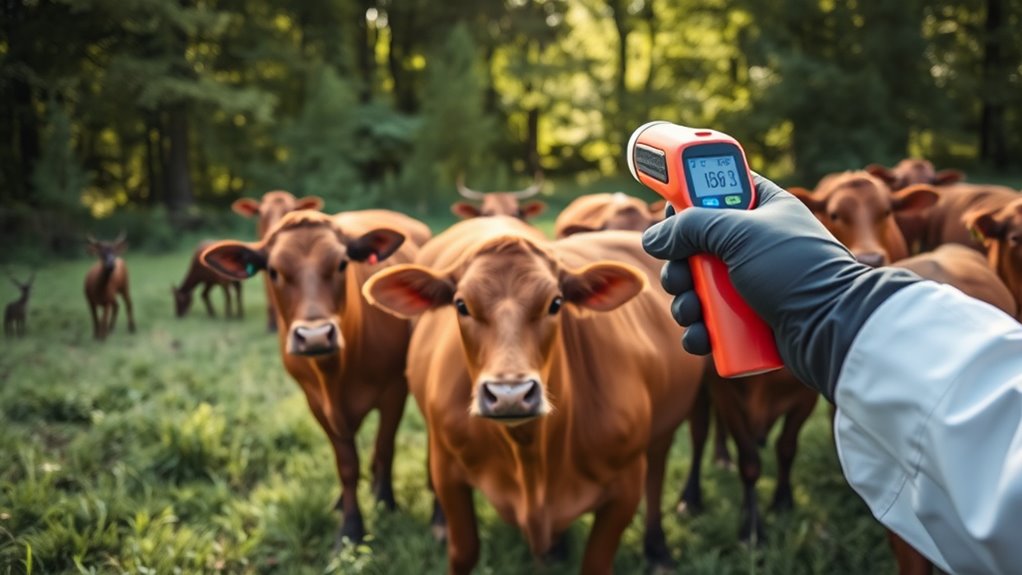
You should stay alert for unusual animal behavior, such as increased agitation or lethargy, which can signal disease transmission. Keep an eye out for visible physical changes like swelling, lesions, or weight loss, as these often indicate infection. Additionally, notice environmental clues, such as droppings or carcasses, that may suggest wildlife is interacting with your livestock and spreading illness. Understanding disease transmission mechanisms can help in implementing effective prevention strategies.
Unusual Animal Behavior
Unusual animal behavior often signals that disease transmission from wildlife to livestock may be occurring. You should stay alert for signs that animals act differently than normal. Look for sudden aggression or withdrawal, which can indicate neurological issues or infection. Notice if animals are restless, pacing, or showing signs of discomfort. Changes in feeding habits, such as refusing food or excessive salivation, may also be warning signs. Additionally, observe if animals exhibit uncoordinated movements or tremors. These behavioral shifts often appear before physical symptoms become obvious. Recognizing these early signs can help prevent disease spread and protect your livestock. Early detection through behavior monitoring is essential to managing and mitigating wildlife-related health threats to your livestock.
Visible Physical Changes
When animals display changes in their physical appearance, it can be a clear sign that a disease has been transmitted from wildlife. You should look for visible symptoms such as swelling, lesions, or unusual discharges. These signs often appear quickly and can indicate infection or inflammation. Early detection is vital to prevent further spread. Use the table below to recognize common physical changes and their possible causes:
| Physical Change | Possible Cause |
|---|---|
| Swelling or lumps | Bacterial or viral infection |
| Discharges from eyes, nose | Respiratory illness |
| Skin lesions or rashes | Parasitic or viral disease |
Monitoring these signs helps you act swiftly to protect your livestock’s health. Recognizing outdoor environments and their influence on disease transmission can further aid in prevention efforts.
Environmental Clues
Environmental clues can provide early warning signs that wildlife may be transmitting diseases to livestock. By paying close attention to your surroundings, you can detect potential risks before outbreaks occur. Look for tracks or droppings near feed or water sources, which may indicate wildlife presence. Unusual animal behaviors, such as increased aggression or lethargy, can also signal disease transmission. Changes in the health status of your livestock, like unexplained weight loss or coughing, are key indicators. Additionally, observe for signs of wildlife intrusion, such as damaged fencing or burrows close to livestock areas. Monitoring these environmental clues helps you act swiftly, reducing the risk of disease spread and safeguarding your farm’s health ecosystem. Regularly inspecting for skilled animal behaviors can help identify early signs of disease transmission from wildlife.
Implementing Effective Biosecurity Measures on Farms
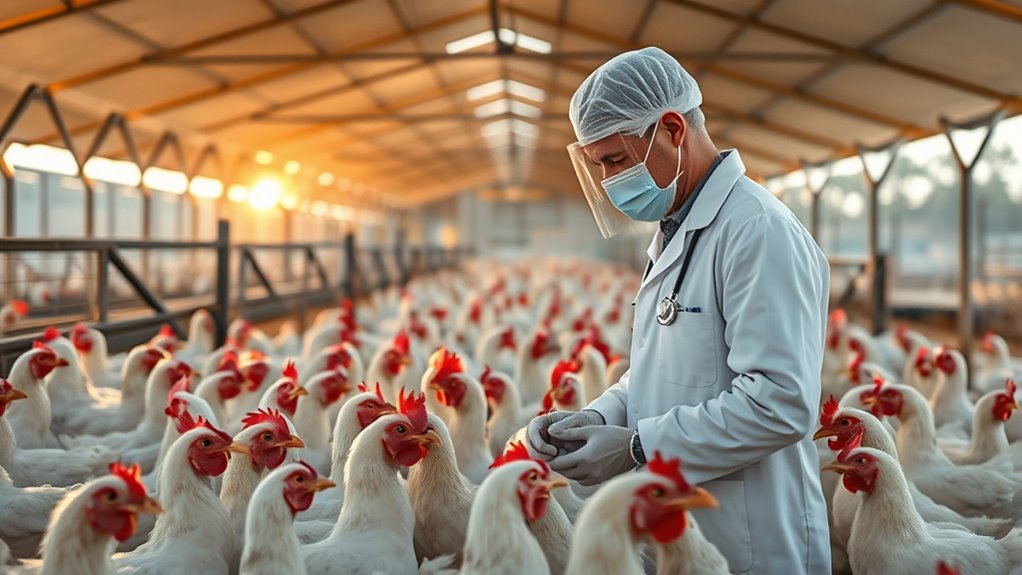
Implementing effective biosecurity measures on farms is essential for preventing the spread of wildlife diseases. You should restrict access to farm areas by controlling visitor entry and ensuring visitors follow strict hygiene protocols. Use disinfectant footbaths and handwashing stations at entry points to reduce disease transmission. Secure feed storage to prevent wildlife from contaminating supplies, and regularly clean and disinfect equipment and surfaces. Keep wildlife away from livestock by managing waste and eliminating attractants like spilled feed or standing water. Educate staff on disease risks and proper biosecurity practices, emphasizing the importance of consistent application. Conducting regular traffic analytics helps monitor the effectiveness of your biosecurity measures and identify potential vulnerabilities. By establishing these measures, you minimize contact between wildlife and your animals, markedly lowering the chances of disease transmission and protecting your farm’s health.
Designing Physical Barriers to Prevent Wildlife Encroachment
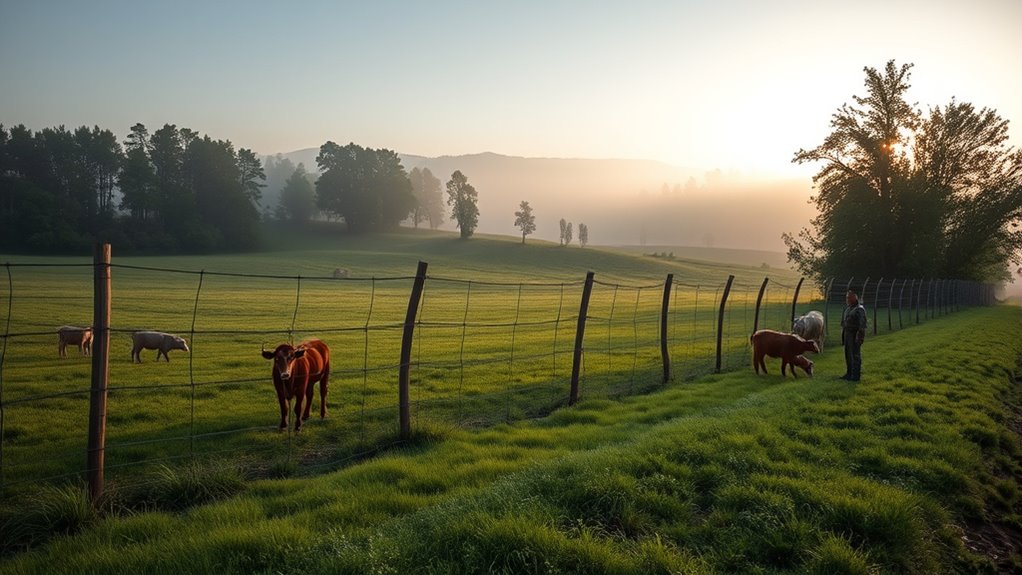
When designing physical barriers, you need to select materials that are both durable and wildlife-proof. Proper placement of these barriers is essential to prevent gaps and weak spots, and you must regularly inspect and maintain them to make certain they stay effective. By focusing on these key points, you can effectively keep wildlife out and protect your farm’s health.
Choosing Appropriate Materials
Choosing the right materials for physical barriers is essential to effectively prevent wildlife from encroaching on protected areas or human infrastructure. Your goal is to select durable, wildlife-proof options that withstand weather and animal attempts to breach. Consider materials that are sturdy and difficult for animals to chew or dig through. For example, galvanized steel or heavy-duty wire mesh provide strength and longevity. Avoid materials that rust easily or degrade over time, as these compromise barrier integrity. Properly chosen materials also reduce maintenance needs and ensure long-term protection. Keep in mind the size and behavior of local wildlife when selecting your materials. Ultimately, the right choice enhances the barrier’s effectiveness, protecting both farm animals and ecosystems efficiently.
Optimal Barrier Placement
Proper placement of physical barriers greatly influences their effectiveness in preventing wildlife from encroaching on protected areas or human infrastructure. To optimize placement, first identify wildlife movement patterns and typical entry points. Position barriers along natural travel corridors or known pathways to intercept animals before they reach sensitive zones. Ensure the barrier extends underground or is buried deep enough to prevent animals from digging underneath. Avoid gaps, holes, or weak points, especially near gates, corners, or utility poles. Consider terrain features; place barriers where slopes or ridges could facilitate animal access. Use visual cues or landscaping to reinforce the barrier’s presence. Regularly review placement based on wildlife activity and adjust as necessary to maintain the barrier’s integrity and effectiveness over time.
Maintenance and Inspection
Regular maintenance and thorough inspections are essential to guarantee that physical barriers remain effective in preventing wildlife from encroaching on protected areas. You should regularly check for damage, wear, and gaps that animals could exploit. Promptly repair any issues to maintain the barrier’s integrity. Keep an eye out for signs of wildlife attempts to breach the barrier, such as scratches or new paths nearby. Maintaining proper fencing height and ensuring gates are secure also matter. Additionally, clear vegetation around the barrier prevents animals from climbing or burrowing underneath. Regular inspections reduce the risk of wildlife entering the farm and spreading diseases. Staying proactive is key to ensuring continuous protection, minimizing the need for costly repairs, and maintaining a safe environment for your animals.
- Check for damage or gaps regularly
- Repair breaches immediately
- Keep vegetation clear around fences
- Ensure gates are secure
Monitoring and Surveillance of Wildlife and Farm Animals
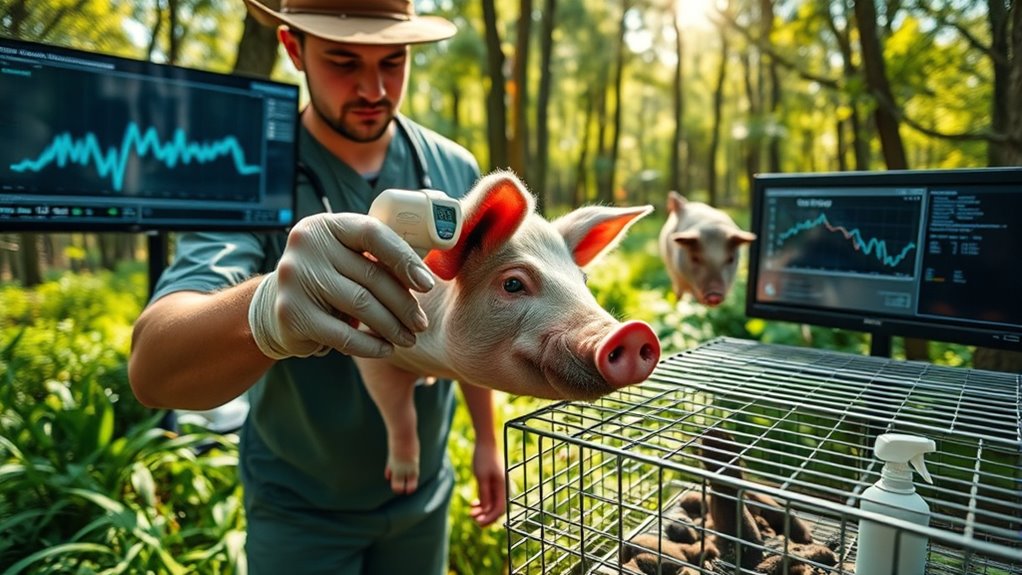
Effective monitoring and surveillance are essential for detecting wildlife and farm animal diseases early, preventing outbreaks from spreading. You should establish regular inspection routines to identify signs of illness promptly. Using appropriate diagnostic tools, such as blood tests or pathogen detection methods, helps confirm suspicions quickly. Tracking disease patterns over time allows you to spot emerging threats and respond swiftly. Collaborating with local authorities and wildlife agencies ensures data sharing and coordinated action. Installing surveillance cameras or sensors in high-risk areas can provide real-time monitoring of animal movements and behaviors. Educating farm workers and wildlife observers to recognize early symptoms enhances your detection capacity. Overall, consistent monitoring and surveillance enable proactive management, reducing the risk of widespread disease transmission.
Vaccination and Preventative Healthcare Strategies
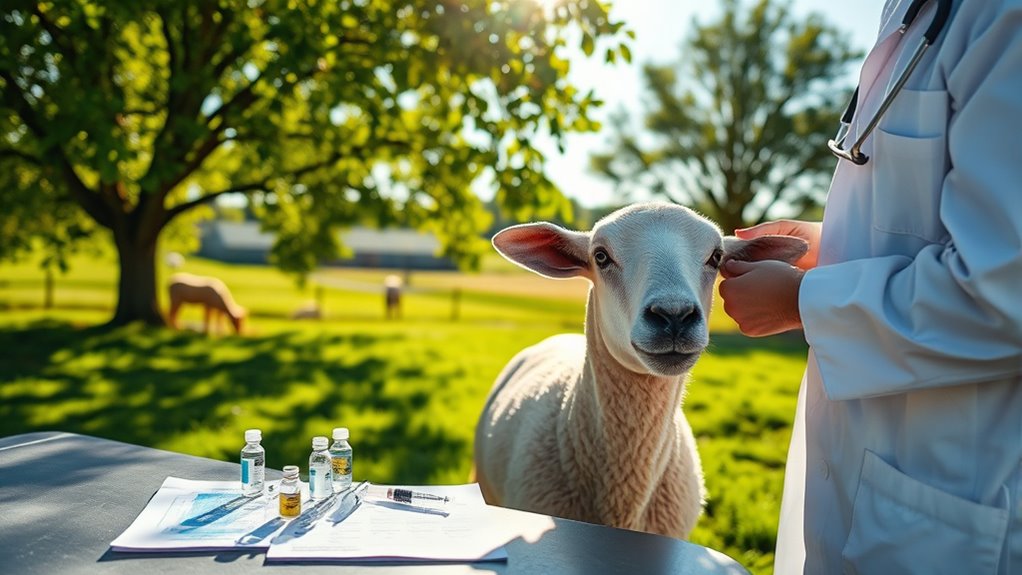
Building on your monitoring efforts, implementing vaccination and preventative healthcare strategies can considerably diminish the risk of disease outbreaks in wildlife and farm animals. You should develop a vaccination schedule tailored to prevalent diseases in your area and ensure timely administration. Regular health checks help identify early signs of illness, enabling prompt action. Maintaining proper hygiene, such as disinfecting equipment and housing, minimizes pathogen spread. Additionally, controlling vectors like ticks and mosquitoes reduces disease transmission. Educating farm staff on disease prevention practices fosters a proactive approach. By combining vaccination, hygiene, vector control, and staff training, you strengthen your defense against wildlife diseases threatening your farm animals. This integrated approach enhances overall herd health and safeguards your livestock’s productivity.
Collaborating With Conservation and Wildlife Agencies
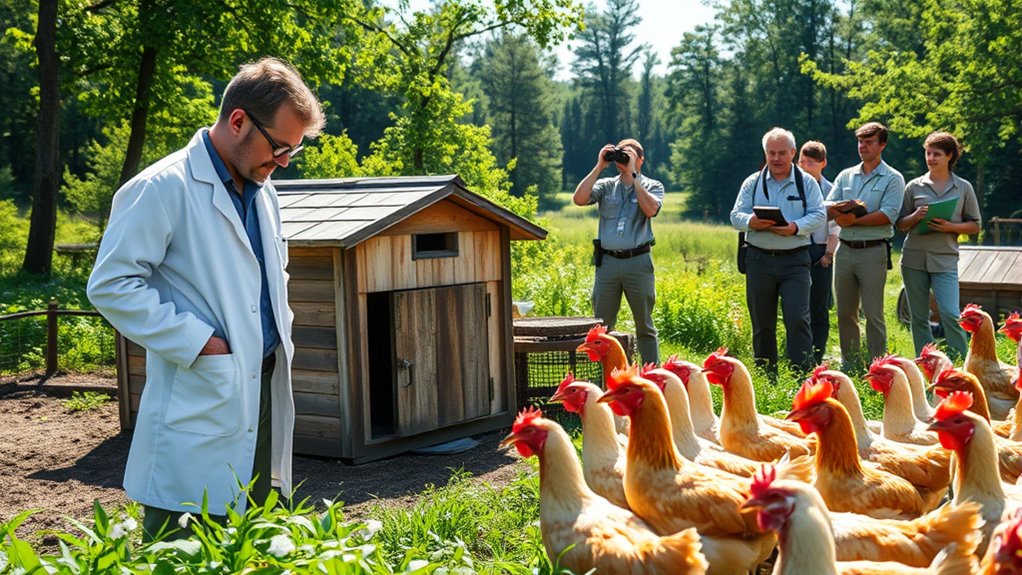
Collaborating with conservation and wildlife agencies is crucial for managing and controlling wildlife diseases effectively. By working together, you can share essential information about disease outbreaks, monitor wildlife populations, and develop coordinated response plans. These agencies have expertise and resources that complement your efforts, helping identify disease reservoirs and transmission pathways. Regular communication ensures timely updates and joint actions, reducing the risk of disease spillover to farm animals. Establishing partnerships also fosters trust and promotes shared responsibility for ecosystem health. You can contribute by providing data from your farms and supporting conservation initiatives. This collaboration helps create extensive strategies that address wildlife health, prevent outbreaks, and protect both wildlife and farm animals from emerging threats.
Responding to Outbreaks and Containing Disease Spread
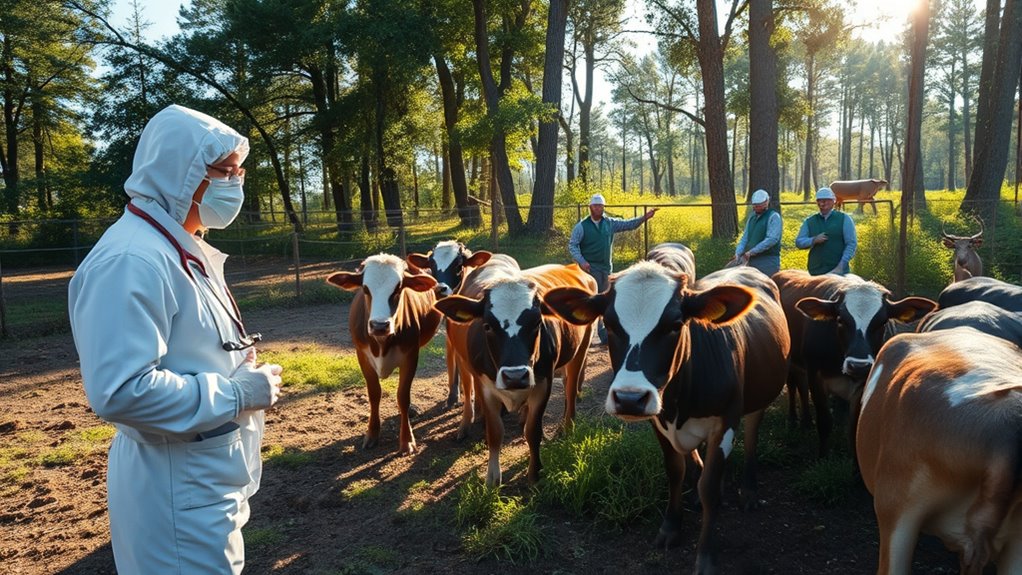
When a wildlife disease outbreak occurs, swift and coordinated action is crucial to contain its spread and protect both wild and domestic populations. Your first step is to identify infected areas quickly and establish quarantine zones. Implement targeted culling or vaccination efforts where necessary to reduce transmission. Monitoring and surveillance help track the outbreak’s progress and effectiveness of your response. Communication with relevant agencies ensures resources are allocated efficiently. You should also enforce movement restrictions on animals and products from affected regions. Rapid response teams need to coordinate efforts, share data, and adapt strategies as new information emerges. Staying vigilant and proactive minimizes the disease’s impact, helping to safeguard farm animals and preserve ecological balance.
Promoting Sustainable Practices to Reduce Disease Risks
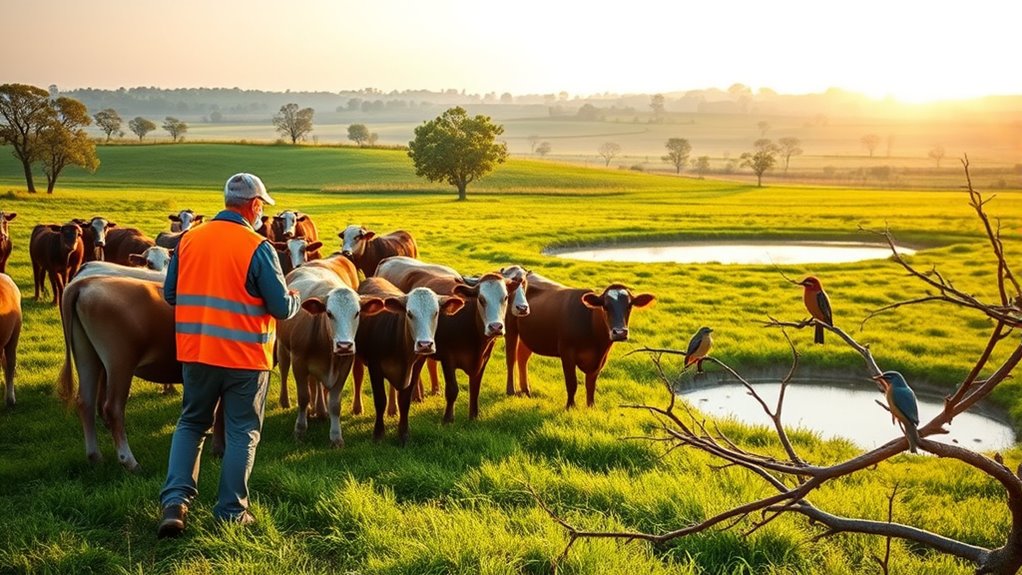
Implementing sustainable practices in wildlife management plays a vital role in reducing disease risks. You can achieve this by maintaining natural habitats to support healthy ecosystems, which naturally regulate wildlife populations and limit overconcentration. Avoiding unnecessary destruction of habitats prevents stress and weakened immune systems in wild animals, reducing their susceptibility to disease. You should also promote responsible feeding and prevent artificial congregation of wildlife around farms, minimizing contact with domestic animals. Additionally, supporting biodiversity helps balance ecosystems and curbs the spread of pathogens. Regular monitoring of wildlife health provides early detection of emerging threats, allowing timely intervention. By adopting these sustainable practices, you help create a healthier environment, lowering the chances of disease transmission to farm animals and safeguarding both agricultural productivity and ecological integrity.
Frequently Asked Questions
How Do Wildlife Diseases Affect Overall Farm Productivity?
Wildlife diseases can markedly reduce your farm’s productivity by causing illness and death in your livestock, leading to decreased milk, meat, or egg production. They may also spread quickly, resulting in costly treatments and increased labor. Additionally, outbreaks can damage your farm’s reputation and lead to stricter regulations. To protect your farm’s productivity, you need to implement effective disease management strategies, monitor for signs of illness, and limit wildlife contact with your animals.
Can Climate Change Influence Wildlife Disease Transmission to Livestock?
Yes, climate change can influence wildlife disease transmission to livestock. Rising temperatures and altered rainfall patterns expand the habitats of disease-carrying animals, increasing contact with farm animals. You might notice more outbreaks as pathogens thrive in changing conditions. By monitoring these shifts, implementing biosecurity measures, and adjusting grazing practices, you can reduce the risk of disease spread caused by climate-related environmental changes.
Are There Legal Restrictions on Wildlife Control Methods Used on Farms?
Are there legal restrictions on wildlife control methods used on farms? Absolutely. You need to follow local, state, or federal laws that regulate humane and environmentally safe wildlife management practices. Ever wondered if your control methods are legal? It’s vital to check regulations before taking action, as illegal methods can lead to fines or penalties. Always consult with wildlife authorities or professionals to guarantee you’re compliant and effectively protecting your livestock.
What Role Do Local Communities Play in Disease Prevention?
You can play a crucial role in disease prevention by staying informed about local wildlife activity and reporting unusual animal behaviors or sick wildlife to authorities. Your community can organize monitoring programs, promote safe farming practices, and support vaccination efforts. By working together, you help reduce wildlife contact with farm animals, minimize disease spread, and create a healthier environment for everyone. Active community involvement is essential for effective disease prevention.
How Can Technology Improve Early Detection of Wildlife-Related Outbreaks?
Technology can substantially improve early detection of wildlife-related outbreaks by enabling you to monitor animal health in real-time through sensors, drones, and camera traps. You can analyze data with advanced software to identify unusual patterns or movements that signal a potential outbreak. Mobile apps and online platforms also allow you to report sightings quickly, helping authorities respond faster and contain diseases before they spread to farm animals.
Conclusion
By staying vigilant and implementing smart strategies, you can turn your farm into a fortress against wildlife diseases. Think of it as fencing off a castle, keeping unwanted invaders at bay and protecting your livestock’s health. With proactive measures and collaboration, you’ll tame the wild risks and nurture a thriving, disease-free farm. Remember, a well-guarded farm is your strongest shield in the battle against nature’s unpredictable challenges.

